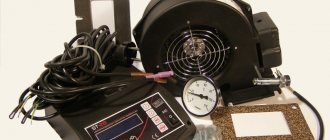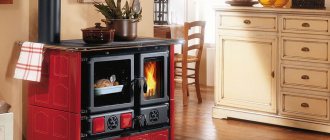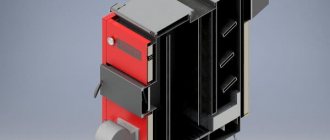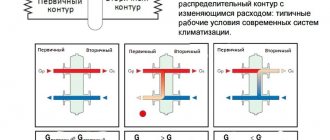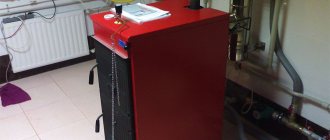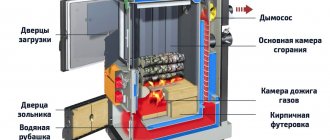Weak boiler power will ruin everything, including the standard of living. Due to excess power, the system will operate in impulses: fuel consumption will increase, and the service life of the equipment will be shortened. The boiler may boil. Or brains. How to calculate correctly, what parameters to take into account, what heat loss is and other customer questions about boiler power can be read here.
How to easily calculate the power of a heating boiler?
You can calculate the approximate power of a boiler for a home by area and volume .
1) A simplified version of calculations by area : 10 kW per 100 m² of a house (or heated area). And this figure will only show the minimum power, below which you cannot fall.
| Graph of boiler versus area |
To take into account climatic zones, coefficients have been developed that correct this formula:
- Central Russia is 1-1.5;
- Northern regions are 1.5-2;
- Southern territories – 0.7-0.9;
- Moscow and Moscow region – 1.2-1.5.
To get closer to a realistic figure, you also need to take into account possible heat loss. To do this, add 10-15% to the minimum value. If the ceilings are higher than 2.7 meters, then we divide the actual ceiling height by the standard height. We get another correction factor.
| Vacation home |
Example:
Let's calculate the power of a boiler for a house in the Moscow region. Ceilings – 3 meters, area – 150 m². A double-circuit boiler is needed - for heat and hot water supply.
The formula gives 15 kW - the minimum power value for the future boiler. Next, to the number 15 we add 10% of heat loss, multiply by the climate coefficient 1.2. The ceilings are higher than 2.7m, so we multiply the resulting figure by a factor of 1.1.
Boiler power = 15 kW (minimum) + 10% (heat loss) * 1.2 * 1.1 = 21.7, rounded to 22 kW.
2) Second formula based on volume : 1 m3 – 40 W. Plus the markups that were included in the first formula, except for the ceiling coefficient. Let's calculate the same house in the Moscow region using this formula.
Boiler power =((150 m²*3m)* 40 W + 10%) * 1.2 * 1.1 =23522 W ≈ 24 kW. The difference between the first and second calculations is 2 kW. The option of calculating boiler power by air volume is the most correct.
You could stop reading this article here. But the difference between an approximate and an exact calculation is in several nuances. What are the nuances, you ask. The answer to this question is contained in the following paragraphs.
What factors need to be considered
The choice of a unit for a country house is influenced by external criteria, the characteristics of the building itself (wall thickness, building and finishing materials used, roofing, area, volume of heated rooms, etc.).
Condition of the premises
When calculating the power of a heating boiler, it is necessary to take into account the design features of the facility:
- building materials used to construct the building;
- ceiling height, wall thickness, room area;
- number and size of windows;
- parameters of entrance openings and doors;
- roof structure and material of manufacture;
- external and internal decoration of the house;
- use of insulating materials.
When calculating the power of a heating boiler, you need to take into account the condition of the room.
The glass area and thermal conductivity of the building must be taken into account.
Dependence on fuel type
Different types of materials can be used for solid fuel units. After burnout, the output power will vary (boiler efficiency):
- Coal: from 490 g you get 5.7 kW/h.
- Firewood: 250 g – 1 kW/h.
- Alder briquettes: 290 g – 3.5 kW/h.
- Sawdust: 300 g – 1 kW/h.
- Wood for making briquettes: 300 g – 3 kW/h.
Each of the listed materials has its own furnace design. Also, to achieve maximum savings, you need to take into account the cost of fuel.
Free area
The specific power of the unit is taken to heat 10 m² of space. Accordingly, when calculating equipment, the area of heated rooms is taken into account.
When calculating equipment, the area of heated rooms is taken into account.
If the boiler is hot water
When purchasing such a heating unit, experts recommend adding 30% to the received power.
What parameters, besides volume and area, influence the choice of boiler? And why is this important?
A simplified calculation formula often leads to the purchase of an unsuitable boiler. Each house is individual, and heat loss percentage cannot be equal for all houses. Before calculating power, consider the data of a specific house:
1) Measure the area of walls, windows, doors;
2) Specify the thickness of the walls, indicate the type of finishing and material, the height of the ceilings;
3) Observe the minimum temperature of the house in cold weather;
4) Determine the desired temperature as a result of installing the boiler;
5) Write down the thermal conductivity values for the materials from which the house was built.
| Wall material | Wall thickness and material thermal resistance | Required thickness for home |
| Brick (1600 kg/m³ - density) | 510 mm (if laying two bricks), R=0.73 °C m²/W | 1380 mm 2190 mm |
| Wooden beam | 150 mm, R=0.83 °С m²/W | 355 mm 565 mm |
| Expanded clay concrete (1200 kg/m³ - density.) | 300 mm, R=0.58 °С m²/W | 1025 mm 1630 mm |
| Wooden panel (inside filled with mineral wool + 25 mm layer of inner and outer cladding) | 150 mm, R=1.84 °С m²/W | 160 mm 235 mm |
| Arbolit | 0.80-0.17W/m² | — |
| Foam concrete | 0.14-0.38 W/m² | — |
| Aerated concrete | 0.18-0.28 W/m² | — |
Thermal resistance of materials
Why is this necessary? The key parameter influencing the choice of boiler is the heat loss of the house. Houses with the same area and volume, but different degrees of insulation, will require equipment of different power.
Where does the heat go:
| Surface | Heat loss in% |
| Roof and ventilation | 20-25% |
| Foundation, if it is adjacent to the ground | up to 15% |
| Walls, windows and doors | 10-15% |
| Ground floor and unheated rooms, basement, for example | up to 15% |
It also matters: how different the outside temperature is from the inside, the climatic region, the strength and direction of the wind, how the house stands relative to parts of the world.
| Heat loss |
About the boiler heat exchanger
After the solid fuel heating boiler has been calculated, you need to decide on the type of heat exchanger, its construction material and capacity.
The heat exchanger can be made from:
- become;
- cast iron
A cast iron heat exchanger is cheaper compared to the cost of a steel one. However, cast iron has a high heat capacity, which is a disadvantage, since it will be difficult to raise the temperature in the firebox to the required 500°C (for complete combustion of fuel and gases). The low thermal conductivity of cast iron will reduce the efficiency of the equipment, because the heat from the combustion reaction will not be transferred to the coolant in full, but will be discharged along with the combustion products into the pipe.
Experts recommend that when constructing a solid fuel heating boiler with your own hands, use heat-resistant or heat-resistant steel for the structural material of the heat exchanger. But processing it requires production conditions, and therefore ordinary structural steel is most often used, as it is easier to work with. Just remember that the temperature of the return flow entering the heater should not fall below +65°C. Otherwise, acidic condensate from the exhaust gases in the furnace falls on the steel heat exchanger, which leads to rust damage to the steel.
A properly designed forced circulation boiler should switch to thermosyphon mode in the event of a power outage. This means that it operates at low power, but contributes to the gravitational movement of the coolant.
To prevent the formation of condensation on the heat exchanger, homemade solid fuel heating boilers should be equipped with either a bypass valve for mixing hot water from the supply pipe into the cold return (this option is suitable for units with a power of up to 12 kW), or an elevator unit (for high-performance equipment operating under pressure).
A do-it-yourself solid fuel heating boiler can be equipped with the following types of heat exchanger:
- with vertical or horizontal registers;
- with flow or counterflow movement of the coolant.
Register-heat exchanger with horizontal coolant circulation.
A horizontal register is simpler in design, however, there is a possibility of incorrect (reverse) movement of the coolant, and therefore it is recommended to construct a heat exchanger with vertical registers.
Register with vertical coolant circulation.
From an efficiency point of view, it is most advantageous to use a register with countercurrent coolant movement. Do-it-yourself heating of a private house with a solid fuel boiler will be the most effective. In this case, the hot gas and coolant move along the same axis, but in the opposite direction to each other, which ensures good heat transfer. The result is high efficiency of the heating element.
How to calculate power taking into account heat loss?
What is heat loss? Let’s say it’s -20 degrees outside, but the average temperature at home is +20 degrees. These quantities are balanced through the exchange of energy. Heat losses occur. The amount of heat loss under severe weather conditions helps to calculate the boiler power with high accuracy.
Step 1
Heat loss is determined by the formula: Q = Q roof + Q walls + Q floor + Q doors + Q windows .
Where the extreme value of Q is the heat loss of each surface of the house.
Each Q value is calculated using the formula: Q = S * T / R
Where Q is heat loss in W, S is the area of a specific surface in m², T is the difference between street and room temperatures in degrees, R is reference data on thermal resistance by type of material.
Step 2
This formula additionally includes involuntary heat loss through cracks, ventilation, exhaust hoods, opening doors and ventilation through windows. For independent calculations without a program, an additional 5% of the total leakage figure is added.
Step 3
Next we move on to determining the boiler power. There are only two formulas to choose from:
Rkot. = ( S room * P beat ) / 10 , where Rkot. — boiler power, Sroom. - the total area of rooms in the house where heating is planned, Pud. — specific power according to climate conditions.
Rkot. = ( Q losses * S from area ) / 100, where Rkot. - boiler power, Qloss - heat loss, Sot. area – total area of heated rooms.
Step 4
For an electric and gas boiler, you can use the table to check:
| Option | House area, m² | Heating, kW | Recommended number of devices | How many people live | DHW boiler, l/kW | Warm floor, m² | Warm floor, kW | Total power | Boiler power | Standard range of boilers, Cat, Ns/A/Nd |
| 1 | 2 | 3 | 4 | 5 | 6 | 7 | 8 | 9 | 10 | 11 |
| 2 | 150 | 19 | 10 | 4 | 100/28 | 16 | 0,75 | 48 | 28 | 28/27/28 |
| 3 | 200 | 22 | 11 | 4 | 100/28 | 20 | 1 | 51 | 28 | 28/27/28 |
| 4 | 250 | 25,5 | 17 | 4 | 160/33 | 20 | 1 | 60 | 33 | 32/35/36 |
| 5 | 300 | 27 | 20 | 6 | 160/33 | 30 | 1,5 | 62 | 34 | -/35/36 |
| 6 | 350 | 31 | 26 | 6 | 200/33 | 40 | 2 | 66 | 39 | -/44/44 |
| 7 | 400 | 4 | 30 | 6 | 200/36 | 50 | 2,5 | 70 | 43 | -/44/44 |
| 8 | 450 | 36 | 44 | 8 | 300/36 | 60 | 3 | 75 | 45 | -/53/52 |
Calculation methods
To maintain a comfortable temperature in residential premises, when installing a heating system yourself, you need to take into account heat loss through the floor, walls, ceiling, door and window structures. There must be a reserve of power in case of severe frosts.
By volume of heated area
Formula for calculating heat:
Q = V × ΔT × K / 850, where
- Q – amount of thermal energy, kW/h;
- V – room volume, m³;
- ΔT – temperature difference between the external and internal air environment;
- K – thermal energy loss coefficient;
- 850 is a constant number for converting to kW/h.
The volume of heat can be calculated based on the volume of the heated area.
Thermal coefficient values for different objects:
- improved building structures (brick walls, thick floors, double-glazed windows in window openings, 2 layers of insulation) – K = 0.6-0.9;
- standard residential buildings - K = 1-1.9;
- simplified house designs with one layer of thermal insulation and standard windows - K = 2-2.9;
- wooden buildings - K = 3-4.
When calculating the required amount of heat for all living rooms of the house, it is necessary to take into account the heating of water for the consumer needs of the family.
By room area
When calculating the amount of heat required for a room, many nuances are taken into account, so this method is more accurate.
Formula: Q = 0.1 × S × k1 × k2 × k3 ….. k7, where
- thermal energy norm – 0.1 kW/m²;
- S – area of the territory;
- k1 – indicator of losses through window structures (single glass unit – 1.27, double glass – 1, triple glass – 0.85);
- k2 – heat consumption by window area (Sw) relative to the floor area Sf (with Sw/Sf = 0.1, k2 = 0.8; respectively, 0.2 to 0.9; 0.3 to 1.0; 0 .4 to 1.1 and 0.5 to 1.2);
- k3 – energy leakage through the walls of the room (when using low-quality insulation material – 1.27; using 15 cm thick material or double brickwork – 1.0; for high-quality insulation – 0.854);
- k4 – heat loss due to external temperature (at T=-10°С, k4=0.7, respectively, -15°С to 0.9; -20°С to 1.1; -25°С to 1 ,3; -30°С to 1.5);
- k5 – energy consumption due to 1 external wall – 1.1; 2 – 1.2; 3 – 1.3; 4 – 1.4;
- k6 – additional amount of heat depending on the height of the ceiling of the room: H=2.5 m, K=1, respectively, 3 m to 1.05; 3.5 m to 1.1; 4 m to 1.15; 4.5 m to 1.2;
- k7 – energy losses depending on the structure located above the heated room (cold attic – K=1, insulated – 0.9, heated room – 0.8).
When performing the calculation, many nuances are taken into account.
For example, the building has 4 external walls, the window openings are equipped with triple-glazed windows, the parameters of which are 30% in comparison with the area of the floor base. Between the ceiling and the roof structure there is a cold attic.
Calculation formula: Q = 0.1 × 200 × 0.85 × 1 × 0.854 × 1.3 × 1.4 × 1.05 × 1 = 27.74 kW/h.
The resulting indicator is increased by the amount of thermal energy that will be needed for hot water supply (if this system is connected to a solid fuel apparatus).
Calculation for a hot water boiler
This indicator is obtained using the following formula:
Qв = с × m × Δt, where
- Qв – energy required for a hot water boiler;
- c – specific heat capacity of the liquid (constant value equal to 4200 J/kg*K);
- m – mass of water;
- Δt – temperature difference between cold and heated liquid.
Incorrectly selected boiler power will lead to increased energy consumption.
For example, a family of 4 people consumes 150 l/day of hot water. The boiler is equipped with a coolant capable of heating the liquid coming from the general communication system from T = 10°C to T = 80°C. In this case, the temperature difference Δt = 80 – 10 = 70°C.
We substitute all the values into the formula and get:
Qв = 4200 J/kg*K × 150 kg × 70 °С = 44,100,000 J (translated as 12.25 kW/h).
For example, you need to heat 150 liters of water for washing at once. Accordingly, the indirect heat exchanger has a capacity of 150 liters. Therefore, to 28.58 kW/h (energy consumption per room), an additional 12.25 kW/h (water heating) must be added. In this case, the value of Qzag is below 40.83 kW/h, i.e. the air temperature in the rooms will be less than the calculated 20°C.
When batch heating the liquid (capacity of the indirect heat exchanger = 50 l), the costs will be 12.25 kW/3 = 4.08 kW/h. Accordingly, Qzag = 28.58 + 4.08 = 32.66 kW/h. This is the required power of heating equipment to maintain room temperature above 20°C and heat a container of water for domestic use.
Why count if you can buy a boiler with a power reserve?
Sometimes boilers have a capacity reserve. This is good when the reserve is no more than 25%. Especially when the family plans to develop the area: complete a swimming pool, sauna, or other heated area. When the required power is exceeded significantly, the owner spends extra money, and the equipment operates in abnormal mode:
| Boiler repair |
- Breaks or malfunctions;
- The efficiency of the system decreases;
- A higher power boiler costs more;
- More fuel is consumed than is required to heat the house;
- A more powerful and expensive pump will be needed;
- The house will be very hot;
- Automatic regulation becomes difficult, the boiler may boil;
- The boiler begins to cycle - it turns on and off in a short period of time, equipment components wear out;
- Condensation appears in the chimney. When burned, the condensate reacts with the emissions and produces acid. It destroys the chimney and sometimes the boiler.
Conclusion: frequent switching on and off wastes more fuel than continuous operation. Buying a boiler with excess power not only makes no sense, but is also harmful to the budget and equipment.
Design and calculation of a homemade mine boiler Glaz6.50
After designing, calculating and manufacturing the Glaz line of boilers, our Teplovhate.by team is embarking on a completely new and complex task of designing and manufacturing a 6.5 kW wood-burning mine boiler. Creating a boiler of such low power is fraught with great difficulties and, as a result, the unit turns out to be complex and expensive, which is not beneficial for manufacturers. Therefore, we decided to create a boiler that should confirm the declared characteristics and be as budget-friendly as possible. And of course, convenient and energy-independent.
If you have any questions about the operation of the site, please call
You can get free consultations at this number.
And the characteristics of the boiler will be as follows:
Rated power 6.5 kW Minimum power 2.5 kW Burning time at maximum power 5 hours Burning time at minimum power 12 hours Minimum chimney height 4 meters Flue gas temperature 120-160 degrees Main fuel is wood.
The boiler will be a shaft type, wood will be loaded from the front (front), and a pilot valve will be required to facilitate ignition. The heat exchanger in the boiler will be fire tube, and we will organize the exhaust of flue gases from the rear wall. We determine the maximum length of firewood to be 33 centimeters. (like the European standard) And from this size we will dance.
Our team has empirically determined that with a water-cooled mine, the minimum power at which stable combustion is still observed is 100 kW per 1 square meter of grate. Or 1 kW per 1 square decimeter. If in our case the rated power is 6.5 kW, then the area of the grate or the cross-section of the shaft will be 6.5 square meters.
S=6.5 Since the length of our firewood is supposed to be 33 cm or 3.3 dm, so that the firewood does not jam in the shaft, we will make its width 34 cm or 3.4 dm. A=3.4 Then the depth of the shaft will be:
B=S/A=6.5/3.4=1.92 dm or 19.2 cm
So we decided on the cross-section of the shaft. Now we calculate the required volume of the mine so that there is enough firewood for the stated 5 hours. The density of dry firewood is approximately 400 kg/cubic meter (or 0.4 kg/liter), and the density of stacking firewood in the shaft (with very good and dense stacking) is about 0.5. Therefore, in 1 liter of mine volume we will put:
0.4*0.5=0.2 kg of wood.
The heat of combustion of dry firewood is about 14 MJ/kg, which in terms of kilowatt hours will be
From these data we find that 0.2 kg of fuel contains:
0.2*3.9=0.78 kW*hours of energy.
We assume the efficiency of our future boiler to be 80 percent and we find that with 0.2 kilograms of fuel we will get useful heat
Due to the fact that we want to remove the power of 6.5 kW from the boiler for 5 hours, the fuel reserve in it should be at
The required volume of the mine will be:
V= 32.5/0.624=52.1 liters
Knowing the width A = 3.4 dm (340 mm) and depth B = 1.92 dm (192 mm), we can easily calculate the height of the shaft (from the grate).
H=V/(A*B)=52/(3.4*1.92)=7.97 dm or 797mm.
The density of wood ash is 750 kilograms per cubic meter or 0.75 kg/liter. It is not difficult to calculate that in a week a volume of ash will accumulate in our ash pit equal to
This is a layer about 8 centimeters thick. As experience shows, it is convenient to maintain and clean a boiler with a vent door at least 150 mm high, and therefore we will set the distance with a margin and it will be 200 mm for good measure. Now let’s imagine that the boiler will stand on legs 20mm high, and the heat exchanger cleaning cover will protrude 50mm from above, and the grate will be 20mm thick. We get the first approximate overall size:
I am sure that this is not the final size and that it will change more than once by several tens of millimeters in some direction. Now let's look at the width of the boiler.
The mine is surrounded by a water jacket and its thickness does not matter when we are talking about several tens of millimeters. Therefore, we will take the thickness of the shirt to be 50 mm on the right and left, add twice 4 mm for each wall to the thickness of the metal and 50 mm to the insulation. The total width of the boiler will be:
Now we have a sketch of the front view projection. For now, we’ll simply designate the loading doors and the blower randomly. We will devote a separate article to the gas window, or rather to the calculation of its cross-section, but with the length of the window we will run ahead of the locomotive and take it to be 140 mm in size. Firstly, this size will be convenient for installing a pilot valve, and secondly, for minimum modes, the gas window will have a kind of tunnel through which gases will pass before entering the afterburner chamber.
Now let's estimate the dimensions of the afterburning chamber. As is known from authoritative sources, for complete combustion of gases, before they touch the cold heat exchanger, it is necessary to remain in a certain volume. For one cubic meter of such volume there should be a power of about 300 kW. If you blow air into the boiler with a fan and rotate the torch, then you can increase this figure, but we have a natural draft boiler, all processes will proceed calmly, and therefore we will take the heat intensity of the afterburner chamber by volume as Qv = 300 kW/cubic meter. Then the required volume of the afterburner for our 6.5 kW will be:
Vcd = 6.5/300 = 0.0216 cubic meters or 21.6 liters.
We already have one size of afterburner. Like the shaft, its width will be 340mm. The depth of the afterburning chamber will have to wait for now because the flow area of the heat exchanger, the speed of the gases in it and, accordingly, the heat capacity depend on it. The depth of the afterburning chamber is also influenced by the gas window, or rather, the speed of gas exit from the window should be such that the torch does not hit the wall, but has time to react. For now, let’s tentatively accept this size as 200 mm. Then the height of the afterburning chamber will be:
How to solve the problem of high power and weak demand?
In an ideal situation, the boiler operates at a constant, rated output. At the same time, the outside temperature is constantly changing, and there are even abnormal jumps. What to do? Four-way mixing valves in the hydraulic system will help. Or an option with thermo-hydraulic distribution. These devices solve the problem not by adjusting the boiler power, but by adjusting the control valve. Or the speed of the circulation pump changes. The temperature of the coolant in the batteries becomes comfortable without disturbing the optimal conditions of the boiler. This solution has a minus - a high price.
| Four way mixing valve |
For gas and liquid fuel boilers, multi-stage burners solve this situation. A lower stage reduces the boiler power if necessary. Advanced models have a smooth adjustment of burner power - modulation. It is cheaper and not as troublesome as the first option.
| Multi-stage gas burner |
Solid fuel boilers also have built-in power settings and automatic fuel supply. This helps solve the issue of excess power when the external temperature changes.
| Automatic fuel supply device for liquid-heat boiler |
The optimal choice of heating equipment - the nuances and subtleties of the issue
*
Having found out for yourself the necessary power parameters of the solid fuel boiler that will be in your home, you can begin to design and install the heating system. You should be aware that the declared data on the thermal load life of the equipment affects the cost of the unit. Low-power heating devices have limited technological capabilities and are designed mainly for heating small rooms. These can be country houses, saunas and country-type guest buildings.
If necessary, the question arises of how to increase the functionality and efficiency of a solid fuel device. In this case, there are reasonable technical and engineering solutions with which increasing the boiler’s performance will have a tangible effect.
Note: the efficiency of the device can be significantly increased by installing an additional heat exchanger in the chimney, which will receive heat from volatile combustion waste escaping into the atmosphere. An economizer (additional heat exchanger) will give an increase of 20-30% to the rated power of the boiler equipment.
It is not advisable to use high-power solid fuel boilers for autonomous heating of residential buildings. Such equipment is cumbersome and requires a special large area for installation. Considering the size and enormous power of industrial boiler equipment, one should remember the significant consumption of fuel resources.
This technique is ideal for heating on an industrial scale. A lot of heat will be required when heating large industrial facilities and structures. Solid fuel units with a large thermal load are installed at enterprises.
What happens if you buy a boiler of lower power?
When the owner made a mistake with the power on the smaller side, this is just as bad as an oversupply. The system is working at its limit. Service life is reduced. The house is not heated sufficiently; the system may freeze during abnormal frosts.
| Freezing of the heating system |
Making a boiler with your own hands
Since the most economical solid fuel heating boilers are pyrolysis units, we will consider the diagram and implementation options for this type of equipment.
Detailed manufacturing diagram of the TT heater.
According to the resulting diagram, you will get the boiler shown below:
Note the electronic display at the top. Its presence means that the unit is volatile.
To successfully complete the job you will need the following tools:
- sheets of heat-resistant steel 6 mm thick;
- pipes of the same material of different diameters;
- fan;
- temperature control device;
- Bulgarian;
- grinding wheel;
- cutting wheel;
- DC welding machine;
- electrodes.
Cheap solid fuel heating boilers are made according to the instructions in the video:
When carrying out work, you must remember that a homemade boiler must be equipped with a limiter, with which you can control the flow of air into the fuel combustion chamber. It is made from a pipe with a diameter of 70 mm. Its length is equal to the length of the heating element body, plus 5 cm on each side. At the bottom of the limiter there should be a steel disk with a diameter of 40 mm, thus creating a hole between it and the walls of the pipe. The other end of the limiter is attached to the boiler body. To do this, a hole of the required diameter is made in the wall.
The loading chamber is made of a rectangular shape. It should be closed by a door, with additional reinforcement made of a steel plate. This will extend the life of the product and ensure a tight fit of the door. The heat exchanger is made in a curved shape. This will increase the level of heat exchange between hot gas and coolant in the heating system. After all, economical solid fuel heating boilers must have high efficiency.
Why contact a specialist?
We found out that buying a boiler from the square is wrong. It is important to consider the heat loss of the building. For example, a house of 300 m² can be heated by a 15 kW boiler if all surfaces are thoroughly insulated. And a house of 150 m² may require 30 kW equipment with thin walls and uninsulated roof and ventilation.
There are hundreds of standards and regulations on this topic, there are dozens of formulas. Sometimes one thing contradicts the other, or standards change and it is difficult for a non-professional to understand whether these requirements are relevant. You can calculate all this armed with a stack of reference books. Or contact specialists who will make accurate calculations in the program and explain all the details. They will help you save money, time, and model an efficient home heating system.
What metal is best to make a boiler from?
The operating time of the boiler depends on the choice of metal. In factory production, there are strict requirements regarding the type of material used for each part of the boiler. Strict requirements are imposed on metal composition, steel thickness and other characteristics.
The material used in the independent manufacture of the unit must comply with similar standards. When choosing, operational features, thermal and mechanical effects and many other aspects are taken into account. Steel and cast iron are used to produce the boiler.
Cast iron
Cast iron has good thermal characteristics: it is resistant to overheating and burnout, and retains heat for a long time. The service life of a boiler made from this metal is at least 25 years. The disadvantage of cast iron is its susceptibility to hydraulic and mechanical shocks, cracking of the heated surface during sudden cooling.
Making a boiler from cast iron at home is impossible. The heat exchanger and other parts of the boiler are produced by injection molding in smelters. It is unrealistic to create such conditions and produce cast iron parts.
Steel
Unlike cast iron, steel is easy to machine. For production, metal is used, rolled into sheets. Grades of steel used, depending on the unit being manufactured:
Steel is easy to process, but has disadvantages associated with operation:
Energy efficiency of different types of fuel
- Combustion of 1 kg of dry sawdust or small pine shavings produces 3.2 kW/h. 1 liter weighs 1.137 kg.
- Alder briquettes are better - 3.5 kW/h. Weight 1 liter – 0.285 kg.
- Briquettes made from hardwood trees produce 3.1 kW/h. 1 liter weighs 0.31 kg.
- The efficiency of DPK coal is 4.85 kW/h. Weight 1 liter – 0.4 kg.
- 1 kg of COOM produces 5.58 kW/h of heat. Weight 1 liter – 0.403 kg.
- Anthracite gives 5.68 kW/h. 1 liter weighs 0.485 kg.
- Belarusian peat – 2.36 kW/h. Weight 1 liter – 0.34 kg.
Some manufacturers indicate the total burning time of one load and do not write how much fuel is burned in 1 hour. In this case, you need to calculate:
- The weight of fuel that can fit in the firebox.
- The amount of heat this fuel will generate. It is adjusted for efficiency.
- The amount of heat released in one hour. The above figure is divided by the combustion time of the entire volume of fuel.
The final figure is the real power of the solid fuel boiler for the heating system, which it can produce in 1 hour.




